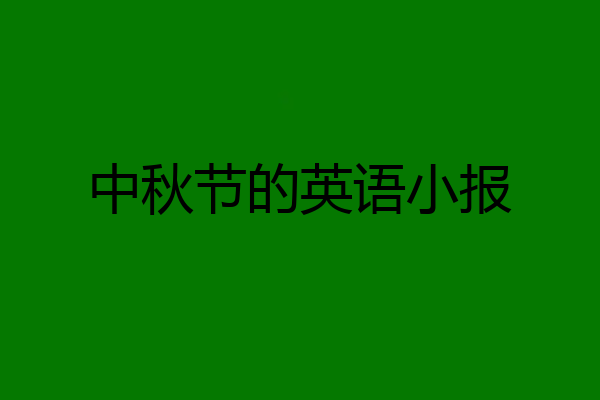
重叠的岁月
很多同学会在中秋节即将到来之际做手抄报,那么英文中秋节手抄报上适合写哪些内容呢?以下是中秋节手抄报的英文素材,供大家参考。
1、Without you, the moon is round though my heart is empty.
没有你在我身边,天上月圆圆,我心却空落落。
2、East or west, home is best.
金窝,银窝不如自己的狗窝。
3、The moon cake is eaten away, but the sweetness remains.
月饼已吃,甜蜜犹存
4、Where we love is home, home that our feet may leave, but not our hearts.
家是我们情之所系的地方,虽只身在外,但心系家园。
5、When we are together, even the moon in the sky will be jealousy.
如果我们在一起,天上的月亮也会嫉妒的。
"Zhong Qiu Jie", which is also known as the Mid-Autumn Festival, is celebrated on the 15th day of the 8th month of the lunar calendar. It is a time for family members and loved ones to congregate and enjoy the full moon - an auspicious symbol of abundance, harmony and luck. Adults will usually indulge in fragrant mooncakes of many varieties with a good cup of piping hot Chinese tea, while the little ones run around with their brightly-lit lanterns.
农历八月十五日是中国的传统节日——中秋节。在这天,每个家庭都团聚在一起,一家人共同观赏象征丰裕、和谐和幸运的圆月。此时,大人们吃着美味的月饼,品着热腾腾的香茗,而孩子们则在一旁拉着兔子灯尽情玩耍。
Mid-autumn Festival
At this time the people always eat the moon cake, to enjoy looking at the moon, the family member reunite, because that day moon is roundest.There are also many wonderful stories about midautumn festival,too.It comes today! I bought some firecrackers and lanterns.After the big dinner,I hang up the lanterns togerther with my sister and then shoot off firecrackers with my family.It was really funny.We was eating mooncakes as well as watching TV.I had a good time with the big family .I love the festival ,it stand for the tuneful of us.
翻译:
在这个节日人们经常喜欢吃月饼,和家庭的成员一起赏月,因为这一天的月亮是最圆的。因此也流传了许多关于中秋节奇妙的故事。今天终于到了。我买了些鞭炮和灯笼。吃完丰盛的晚餐以后,姐姐陪同我一起去挂灯笼,过后我们全家一起放鞭炮,是在是兴奋极了。我们还边看电视边吃月饼呢!也和家人们度过了美好的时光。我喜欢这个节日,它代表家庭的和谐。
以上就是英文中秋节手抄报的素材信息,希望对大家有所帮助。


小北京西城
英文版中秋节手抄报,你值得拥有!
下面是小编整理的英文手抄报,一起看看吧!
中秋节是什么?
To the Chinese, Mid-Autumn Festival means family reunion and peace. The festival is celebrated when the moon is believed to be the biggest and fullest. To the Chinese, a full moon is a symbol of prosperity, happiness, and family reunion.
中国人怎么过中秋?
Many traditional and meaningful celebrations are held in most households in China, and China's neighboring countries. The main traditions and celebrations include eating mooncakes, having dinner with family, gazing at and worshipping the moon, and lighting lanterns.
中秋节起源
Mid-Autumn Festival has a history of over 3,000 years, dating back to moon worship in the Shang Dynasty (1600–1046 BC). It’s such an important festival that many poems were written about it, stories and legends about the festival are widespread, and its origins have been guessed at and explained by generations of Chinese.
中秋祝福语(英文版)
Happy Mid-Autumn Festival!
Wish you and your family a happy Mid-Autumn Festival.
Wishing us a long life to share the graceful moonlight, though thousands of miles apart.
A bright moon and stars twinkle and shine. Wishing you a merry Mid-Autumn Festival, bliss, and happiness.
Happy Mid-Autumn Festival! May the round moon bring you a happy family and a successful future.
The roundest moon can be seen in the autumn. It is time for reunions. I wish you a happy Mid-Autumn Day and a wonderful life.
Wish you a perfect life just like the roundest moon in Mid-Autumn Day.
Happy Mid-Autumn Day! Wish that you go well and have a successful and bright future.
I want to make a toast. I Wish that the round moon take my best blessing to you. May you have a happy family and a bright future.
I wish that your career and life, just like the round moon on Did-Autumn Day, be bright and perfect.
这些就是小编整理的中秋节英文手抄报,有没有你心仪的呢?

京城第一伪娘
怎么做英语中秋节手抄报呢?
下面是小编找到的一些别人做的英语版中秋节手抄报,快快跟着学起来吧!
Mid-Autumn Day 中秋节
The joyous Mid-Autumn Festival was celebrated on the fifteenth day of the eighth moon, around the time of the autumn equinox(秋分). Many referred to it simply as the "Fifteenth of the Eighth Moon".
This day was also considered as a harvest festival since fruits, vegetables and grain had been harvested by this time and food was abundant. Food offerings were placed on an altar set up in the courtyard. Apples, pears, peaches, grapes, pomegranates(石榴), melons, oranges and pomelos(柚子) might be seen. Special foods for the festival included moon cakes, cooked taro(芋头)and water caltrope(菱角), a type of water chestnut resembling black buffalo horns. Some people insisted that cooked taro be included because at the time of creation, taro was the first food discovered at night in the moonlight. Of all these foods, it could not be omitted from the Mid-Autumn Festival.
The Mid-Autumn Festival is a traditional festivity for both the Han and minority nationalities. The custom of worshipping the moon can be traced back as far as the ancient Xia and Shang Dynasties (2000 B.C.-1066 B.C.). In the Zhou Dynasty(1066 B.C.-221 B.C.), people hold ceremonies to greet winter and worship the moon whenever the Mid-Autumn Festival sets in. It becomes very prevalent in the Tang Dynasty(618-907 A.D.) that people enjoy and worship the full moon. In the Southern Song Dynasty (1127-1279 A.D.), however, people send round moon cakes to their relatives as gifts in expression of their best wishes of family reunion. When it becomes dark, they look up at the full silver moon or go sightseeing on lakes to celebrate the festival. Since the Ming (1368-1644 A.D. ) and Qing Dynasties (1644-1911A.D.), the custom of Mid-Autumn Festival celebration becomes unprecedented popular. Together with the celebration there appear some special customs in different parts of the country, such as burning incense(熏香), planting Mid-Autumn trees, lighting lanterns on towers and fire dragon dances. However, the custom of playing under the moon is not so popular as it used to be nowadays, but it is not less popular to enjoy the bright silver moon. Whenever the festival sets in, people will look up at the full silver moon, drinking wine to celebrate their happy life or thinking of their relatives and friends far from home, and extending all of their best wishes to them.